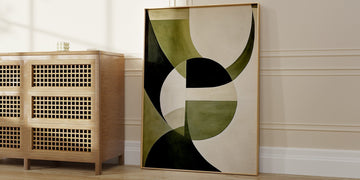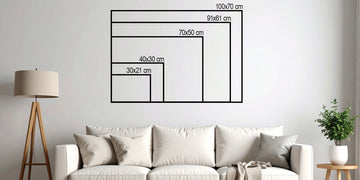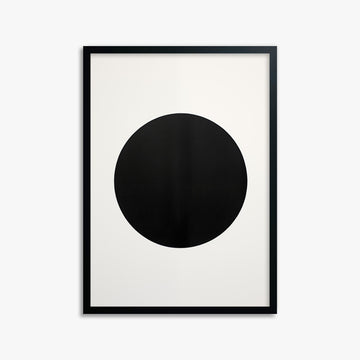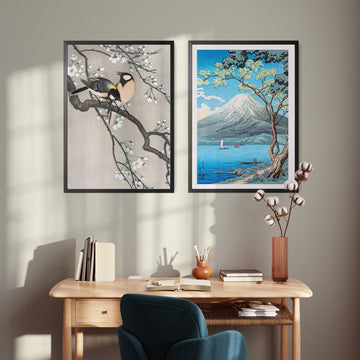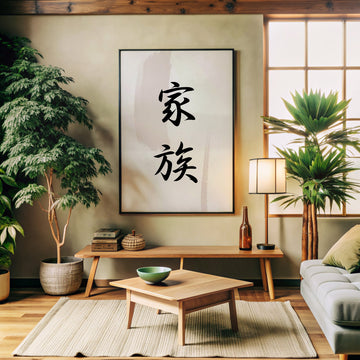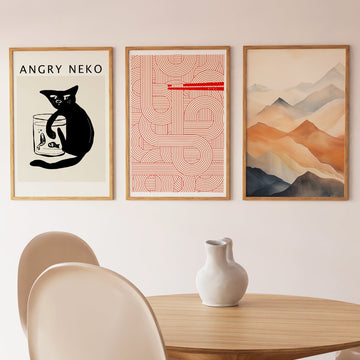Staring at your flat and feeling like you're drowning in stuff? That pile of clothes on "the chair" has become a permanent installation, your coffee table has disappeared under a mountain of random objects, and you can't remember the last time you saw your actual floor? Meanwhile, your walls are covered with a chaotic mix of old posters, random art prints, and photos that no longer spark joy - creating visual clutter that adds to the overwhelming feeling.

Here's the thing: decluttering doesn't have to involve crying over childhood memories or making life-altering decisions about whether you might need that pasta maker "someday". The Japandi approach to decluttering is like having a zen master and a hygge enthusiast team up to help you create a space that actually makes you feel calm instead of stressed - including transforming your walls into peaceful, intentional displays.
If you're ready to transform your chaotic cave into a tranquil sanctuary but don't know where to start, this guide will walk you through the gentle, mindful Japandi way of decluttering that actually sticks (and won't leave you feeling like you've been emotionally ransacked).
What Exactly Is Japandi Decluttering and Why Should I Care?
Japandi decluttering isn't about throwing everything away and living like a monk (unless that's your vibe, no judgment). It's about creating intentional spaces that support your actual lifestyle while embracing the Japanese concept of "less but better" and the Scandinavian idea of "cozy functionality."
Core Japandi decluttering principles
- Intentional keeping - Every item should have a purpose and a place
- Quality over quantity - Better to have fewer, well-made things
- Natural harmony - Items should feel cohesive and peaceful together
- Functional beauty - Things should be both useful and pleasing to look at
- Mindful consumption - Think before buying, keep what serves you
- Sustainable choices - Consider the environmental impact of your decisions
- Visual calm - Wall displays should promote peace, not overwhelm
Unlike Marie Kondo's "spark joy" method (which can feel overwhelming when your serotonin is broken), Japandi decluttering asks: "Does this support the life I want to live?" It's more forgiving, more practical, and honestly, more realistic for people juggling work, social lives, and the general chaos of being a functioning adult in 2025.
Why Is My Generation So Overwhelmed by Stuff?
Let's be real - millennials and Gen Z have inherited a perfect storm of stuff accumulation. We grew up in peak consumerism, survived multiple economic crises (hello, anxiety shopping), live in smaller spaces than previous generations, and have been conditioned to believe that more stuff equals more happiness.
The modern clutter crisis includes
- Fast fashion overload - Cheap clothes that fall apart but guilt prevents throwing away
- Tech graveyard - Old phones, cables, chargers for devices we no longer own
- Wall art chaos - Years of accumulated posters, prints, and random decorations creating visual noise

- Sentimental hoarding - Everything feels meaningful when you're uncertain about the future
- Small space syndrome - Too much stuff, not enough storage solutions
- Impulse buying culture - Social media makes everything look necessary
- Gift accumulation - Well-meaning relatives and friends adding to the pile
The good news? Recognizing the problem is the first step, and Japandi principles offer a sustainable way out of the clutter trap that doesn't require you to get rid of everything you own - including creating cohesive, calming wall displays that actually enhance your space.
How Do I Start Decluttering Without Having a Breakdown?
The biggest mistake people make when decluttering is trying to do everything at once. That's a recipe for overwhelm, decision fatigue, and ultimately giving up. The Japandi approach is gentler - think of it as mindful curation rather than aggressive purging.
Start with the Japandi mindset shift
- You're not "getting rid of stuff" - you're "choosing what to keep"
- Progress over perfection - small steps still count
- Function follows feeling - how do you want your space to make you feel?
- One category at a time - don't try to declutter everything simultaneously
- No shame, only progress - your clutter didn't happen overnight, and it won't disappear overnight
- Visual harmony matters - consider how items work together, especially on walls
The 15-minute rule: Set a timer for 15 minutes and work on one small area. When the timer goes off, stop. This prevents overwhelm and makes the task feel manageable. You'll be surprised how much you can accomplish in just 15 focused minutes - like finally organizing that pile of prints and posters you've been meaning to sort through.

Which Room Should I Declutter First?
Not all rooms are created equal when it comes to decluttering difficulty. Starting with the right space sets you up for success and builds momentum for tackling the harder areas later.
Best rooms to start with
1. Bathroom (Easiest wins)
- Small space, clear categories
- Easy decisions (expired = gone)
- Immediate visual impact
- Builds confidence for bigger projects
2. Kitchen counters (Quick satisfaction)
- Clear surfaces make cooking more enjoyable
- Easy to maintain once cleared
- Functional benefits are immediately obvious
3. Bedroom (Sleep quality improvement)
- Directly impacts your daily well-being
- Creates immediate calm
- Easier decisions about clothes you actually wear
- Perfect place to start curating peaceful wall art
Rooms to tackle later
- Living room - Often shared space with complex decisions about furniture and wall displays
- Home office - Usually contains important documents requiring careful sorting
- Storage areas - Can become overwhelming quickly
How Do I Declutter My Bedroom the Japandi Way?
Your bedroom should be a sanctuary that promotes rest and calm. If you're currently using your bed as a filing system and your floor as a wardrobe, it's time for some Japandi intervention.
Start with surfaces
- Clear your nightstand - Keep only essentials: lamp, book, water, maybe one meaningful object
- Tackle "the chair" - You know the one. Put clothes away properly or add them to laundry
- Make your bed - Instant visual calm and psychological boost
Address your walls: Your bedroom walls significantly impact sleep quality and morning mood. Look at your current wall displays with fresh eyes:
- Remove overwhelming gallery walls - Too many pieces create visual chaos
- Take down outdated posters - That college band poster might not serve your current aesthetic
- Choose calming artwork - Opt for peaceful, neutral pieces that promote rest
- Consider a single statement piece - One beautiful print above your bed can be more impactful than multiple smaller pieces
Poster: Geometric Harmony
Wardrobe decluttering strategy
The "One Year Rule":
- Haven't worn it in a year? It goes
- Doesn't fit your current lifestyle? It goes
- Requires too much maintenance for your reality? It goes
The "Joy vs. Function" test
- Does it make you feel good when you wear it? Keep
- Do you reach for it regularly? Keep
- Is it just taking up space? Let it go
Japandi wardrobe principles
- Quality over quantity - fewer, better pieces
- Neutral base - colors that work together effortlessly
- Natural materials - cotton, linen, wool feel better and last longer
- Versatile pieces - items that work for multiple occasions
Create designated homes: Every item should have a specific place. Use drawer dividers, install hooks, or invest in quality hangers that make you want to hang things up properly.
What's the Secret to Decluttering My Living Room?
The living room is often the most challenging space because it's multifunctional - relaxation zone, entertainment center, dining area, home office, and social space all rolled into one. The key is creating zones while maintaining visual calm.
Surface-by-surface approach
Coffee table decluttering:
- Keep only items you use daily
- Create a small tray for remote controls
- Add one beautiful object (plant, candle, book)
- Everything else needs a proper home
Wall decluttering - the forgotten clutter zone: Your walls might be contributing more to visual chaos than you realize:
- Audit your current wall art - Step back and assess what's actually displayed
- Remove mismatched pieces - That random collection of prints from different eras creates visual noise
- Group similar themes - If you love botanical prints, commit to a cohesive botanical wall rather than mixing styles
- Consider scale and spacing - Too many small pieces scattered around feel chaotic
- Quality over quantity - One beautiful, well-sized piece often works better than multiple smaller ones
TV area optimization:
- Hide cables and tech clutter
- Choose one streaming device instead of multiple
- Store games and movies in closed storage
- Keep only the books you'll actually re-read on display
Shelving strategy:
- Follow the "rule of thirds" - 1/3 books, 1/3 objects, 1/3 empty space
- Group similar items together
- Mix vertical and horizontal book stacking
- Add plants or natural elements for visual break
Furniture functionality - choose pieces that serve multiple purposes:
- Ottoman with storage for blankets and games
- Console table that hides tech equipment
- Baskets that look good and contain clutter
How Do I Deal with Sentimental Items Without Crying?
This is where most decluttering attempts go to die - the emotional attachment minefield. The Japandi approach acknowledges that some things matter beyond their function, but helps you distinguish between meaningful memories and clutter disguised as sentiment.
The sentimental sorting system
Category 1: True treasures
- Items with irreplaceable personal history
- Things that genuinely make you smile when you see them
- Objects that connect you to important people or experiences
- Display these thoughtfully, don't hide them in boxes
Category 2: Guilt keepers
- Gifts you don't like but feel bad about discarding
- Items from expensive purchases you regret
- Old posters and prints that represent who you used to be, not who you are
- Artwork that no longer fits your style but you keep "because it was expensive"
- These can go - your guilt doesn't honor the giver or your past self
Category 3: "Just in case" items
- Things you might need someday (but probably won't)
- Duplicates "for backup"
- Extra frames and art supplies collecting dust
- Items you keep because they were expensive (but don't use)
- If you haven't needed it in two years, you probably never will

Special note on wall art and posters: Your taste evolves, and that's perfectly normal. Those band posters from university or that abstract print you bought during your "colorful phase" might not align with the calm, intentional space you're creating now. Consider:
- The photo technique - Take a picture of meaningful but outdated pieces
- Gifting to friends - Someone else might love that vintage poster
- Rotating seasonal storage - Keep a few favorites to rotate periodically
What Do I Do with All This Stuff Once I've Decided to Let It Go?
This is crucial - having a plan for your discarded items prevents them from sitting in bags by your door for months (creating new clutter). The Japandi philosophy extends to responsible disposal that considers the item's next life.
The sustainable disposal hierarchy
1. Rehome to friends/family
- Post in group chats or social media
- Host a "free shop" party with friends
- Art swap parties - exchange prints and posters with friends
- Gift items to people who'll actually use them
2. Sell valuable items
- Use Vinted, eBay, or Facebook Marketplace for clothes and accessories
- Online art marketplaces for valuable prints or vintage posters
- Try Marktplaats (Netherlands), Blocket (Sweden), or local equivalents
- Electronics and tech often have good resale value
3. Donate thoughtfully
- Research local charities and their needs
- Ensure items are clean and in good condition
- Art centers and schools often welcome poster and print donations
- Consider specialized donations (books to libraries, business clothes to job centers)
4. Recycle properly
- Electronics to dedicated e-waste centers
- Paper prints and posters to paper recycling
- Textiles to textile recycling programs
- Check your local council's recycling guidelines
5. Last resort: bin it
- Only for items truly beyond use
- Try to minimize this category through better initial decisions
The 24-hour rule: Place items to be discarded in a staging area for 24 hours. If you don't miss them or think about them, proceed with disposal. This prevents regret without enabling hoarding.
How Do I Maintain My Newly Decluttered Space?
Decluttering is only half the battle - keeping it that way requires developing new habits that align with Japandi principles. The goal isn't perfection; it's creating systems that make maintaining order feel natural.
Daily Japandi habits
1. The 10-minute evening reset
- Clear surfaces before bed
- Put items back in their designated homes
- Straighten wall art and ensure everything is level
- Prepare tomorrow's essentials
- Creates morning calm and evening closure
2. One in, one out rule
- Buy a new shirt? Donate an old one
- New artwork? Replace an existing piece
- New book? Pass on one you've read
- Prevents accumulation without conscious choice
3. Weekly space check
- Spend 15 minutes each week assessing one area
- Notice what's collecting clutter
- Check if wall displays still serve you
- Adjust systems that aren't working
4. Monthly mini-declutter
- Go through one drawer, shelf, or small area
- Rotate seasonal artwork if you have pieces in storage
- Prevents major accumulation
- Keeps the habit alive without overwhelm
Mindful consumption practices:
- 24-hour rule for purchases - Want something? Wait a day and see if you still want it
- Buy experiences over things - Invest in memories rather than objects
- Choose quality over convenience - Better to save for one good piece than buy multiple cheap ones
- Consider wall space before buying art - Do you have room for it? Does it fit your aesthetic?
- Consider the full lifecycle - Where will this item go when you're done with it?
What Are the Biggest Japandi Decluttering Mistakes to Avoid?
Learning from common mistakes can save you time, energy, and the frustration of starting over. Here are the pitfalls that trip up most people attempting Japandi-style decluttering:
Mistake #1: Trying to do everything at once
- The fix: Focus on one small area at a time
- Why it matters: Overwhelm leads to giving up
Mistake #2: Buying organizing products before decluttering
- The fix: Declutter first, then see what storage you actually need
- Why it matters: You might not need as much storage as you think
Mistake #3: Keeping things "just in case"
- The fix: Be honest about your actual lifestyle and needs
- Why it matters: "Just in case" items rarely get used and create mental clutter
Mistake #4: Perfectionism paralysis
- The fix: Progress over perfection—messy action beats perfect inaction
- Why it matters: Done is better than perfect
Mistake #5: Not dealing with disposal immediately
- The fix: Have bags/boxes ready and a plan for where items will go
- Why it matters: Bags of "donations" become new clutter
Mistake #6: Decluttering other people's stuff
- The fix: Focus only on your own belongings
- Why it matters: Respects boundaries and prevents conflict
Mistake #7: Ignoring wall clutter
- The fix: Include wall displays in your decluttering process
- Why it matters: Visual clutter affects mental state just as much as physical clutter
How Do I Handle Decluttering When I Live with Others?
Shared spaces require diplomacy, compromise, and clear communication. You can't force others to embrace Japandi principles, but you can model them and create agreements that work for everyone.

Strategies for shared spaces
1. Start with your own stuff
- Focus on items that are clearly yours
- Don't touch shared or others' belongings without permission
- Begin with your personal wall displays in your own room
- Lead by example rather than criticism
2. Propose shared benefits
- Frame decluttering in terms everyone can appreciate
- "More space for entertaining" or "easier to find things"
- "Calmer walls help everyone relax"
- Focus on function rather than aesthetics
3. Create household agreements
- Establish systems for shared items
- Agree on standards for common areas
- Develop guidelines for shared wall spaces
- Regular household decluttering sessions
4. Respect different approaches
- Not everyone will embrace minimalism
- Find compromises that work for all personalities
- Allow personal expression while maintaining overall harmony
- Focus on function and cleanliness over perfect aesthetics
What About Digital Decluttering? Does That Count?
Absolutely! Digital clutter creates mental stress just like physical clutter. The Japandi approach to digital spaces emphasizes the same principles: intention, functionality, and calm.
Digital decluttering priorities
Photos and files:
- Delete duplicates and blurry photos
- Organize inspiration images and design references into meaningful folders
- Use cloud storage thoughtfully, not as a dumping ground
- Regular backups prevent panic-induced hoarding
Apps and subscriptions:
- Delete unused apps monthly
- Cancel subscriptions you don't actively use
- Unsubscribe from design blogs that create comparison stress
- Organize remaining apps into functional categories
- Turn off notifications for non-essential apps

Social media:
- Unfollow accounts that create comparison or stress
- Curate your feed to include inspiring, calm design content
- Use "mute" functions liberally
- Curate feeds that inspire rather than exhaust
- Regular social media breaks maintain perspective
Email and messaging:
- Unsubscribe from unnecessary lists
- Keep only design newsletters that truly inspire you
- Create folders for important emails
- Regular inbox clearing sessions
- Use auto-replies to manage expectations
How Long Does Japandi Decluttering Actually Take?
This is the question everyone wants answered, but the truth is it depends on your starting point, living situation, and how much stuff you've accumulated. The good news? You'll start feeling benefits immediately, even if the full process takes months.
Realistic timeline expectations
Week 1-2: Quick wins
- Bathroom and kitchen surfaces cleared
- Bedroom floor visible
- Initial wall art assessment completed
- Basic systems in place
- Immediate stress reduction
Month 1: Foundation building
- Main living areas decluttered
- Wall displays simplified and cohesive
- Daily maintenance habits forming
- Donation and disposal systems working
- Noticeable improvement in daily life
Months 2-3: Deep work
- Storage areas tackled
- Sentimental items sorted
- Seasonal art rotation system established
- Systems refined and personalized
- Mindful consumption habits developing
Months 4-6: Maintenance mode
- Habits feel natural
- Space stays organized with minimal effort
- Wall displays support your mood and goals
- Continued refinement rather than major overhauls
- Sustainable long-term practices established
Remember: This isn't a race. The goal is creating a sustainable lifestyle that supports your well-being, not achieving some impossible standard of perfection.
Ready to Start Your Japandi Decluttering Journey?
Decluttering the Japandi way isn't about creating a sterile, empty space - it's about creating a home that supports the life you actually want to live. Every item you choose to keep should either serve a function or bring you genuine pleasure. Everything else is just taking up space and mental energy you could be using for better things.
Start small, be patient with yourself, and remember that this is a practice, not a destination. Your space should evolve with you, and that's perfectly okay. The goal isn't to create a magazine-perfect home; it's to create a space that feels like a sanctuary where you can recharge, create, and simply be.
The most beautiful thing about Japandi decluttering is that it teaches you to value what you have rather than constantly wanting more. In a world that profits from your dissatisfaction, creating a peaceful, intentional space is actually a radical act of self-care.
Take a deep breath, set a timer for 15 minutes, and choose one small area to start with. Your future self will thank you for every small step you take today.
Ready to create a more tranquil space? Our collections of Japandi-inspired wall art can help transform your newly decluttered walls into peaceful focal points that support your mindful living journey.







